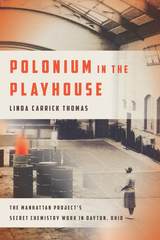
Seized by the War Department in 1944 for the bomb project, the Runnymede Playhouse was transformed into a polonium processing facility, providing a critical radioactive ingredient for the bomb initiator—the mechanism that triggered a chain reaction. With the help of a Soviet spy working undercover at the site, it was also key to the Soviet Union’s atomic bomb program.
The work was directed by industrial chemist Charles Allen Thomas who had been chosen by J. Robert Oppenheimer and General Leslie Groves to coordinate Manhattan Project chemistry and metallurgy. As one of the nation’s first science administrators, Thomas was responsible for choreographing the plutonium work at Los Alamos and the Project’s key laboratories. The elegant glass-roofed building belonged to his wife’s family.
Weaving Manhattan Project history with the life and work of the scientist, industrial leader and singing-showman Thomas, Polonium in the Playhouse offers a fascinating look at the vast and complicated program that changed world history and introduces the men and women who raced against time to build the initiator for the bomb.

The days of intricate test-ban negotiations, Khrushchev's visit to Camp David, the cranberry controversy, the impending rupture with Cuba, the downed U-2, and the failed Summit in Paris come to life again in this highly personal diary kept by the Ukrainian-born chemist who was President Eisenhower's science advisor. Richly detailed, candid, and very human, the memoir offers an inside view of White House infighting, policy disputes, and bureaucratic conflict, and of the role an eminent scientist came to play in shaping presidential decisions. It records the interaction between the scientific community and the defense establishment during a critical period in the making of United States foreign policy. Throughout, Kistiakowsky's growing admiration for the President becomes clear.
George Kistiakowsky became President Eisenhower's special assistant for science and technology in July 1959, and he served until John F. Kennedy's inauguration. He was the second person to hold this office, which was created by Eisenhower and would be abolished under Nixon. After considerable pressure from the scientific community, President Ford reinstated the position on the White House staff in August 1976.
From the day he took office, Kistiakowsky kept a private journal of his activities and conversations. This diary, edited and annotated, is a readable and informative chronicle; it adds substantially to our knowledge of day-to-day operations in the office of the President. It records the progress of a citizen-expert who struggled to serve the President and the country with objective information and dispassionate analysis--but who also had his own strong ideas and passionate beliefs.
With an introduction by Charles S. Maier and supplemented by Kistiakowsky's own reminiscences and commentary, this book can be read either as a primary document or as entertaining background; it is a unique contribution to contemporary history.
READERS
Browse our collection.
PUBLISHERS
See BiblioVault's publisher services.
STUDENT SERVICES
Files for college accessibility offices.
UChicago Accessibility Resources
home | accessibility | search | about | contact us
BiblioVault ® 2001 - 2024
The University of Chicago Press









